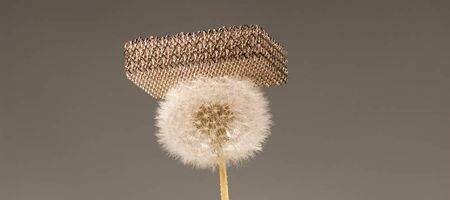A team of researchers from UC Irvine, HRL Laboratories and the California Institute of Technology have developed the world’s lightest material – about one hundred times lighter than Styrofoam.

With a density of 0.9 mg/cc, the new material is based on a unique ‘micro-lattice’ architecture based on hollow tubes made of nickel, and consists of 99.99 percent air. The walls of the tubes are 1,000 times thinner than a human hair.
The material shows ‘unprecedented mechanical behavior’ for a metal, they say. For example, after being compressed, it can bounce back to its original shape almost perfectly. It’s also extremely strong.
“Modern buildings, exemplified by the Eiffel Tower or the Golden Gate Bridge, are incredibly light and weight-efficient by virtue of their architecture,” says William Carter, manager of the architected materials group at HRL.
“We are revolutionizing lightweight materials by bringing this concept to the nano and micro scales.”
Developed for the Defense Advanced Research Projects Agency, the material could be used for battery electrodes and acoustic, vibration or shock energy absorption, says the team.
“Materials actually get stronger as the dimensions are reduced to the nanoscale,” says UCI mechanical and aerospace engineer Lorenzo Valdevit.
“Combine this with the possibility of tailoring the architecture of the micro-lattice and you have a unique cellular material.”





